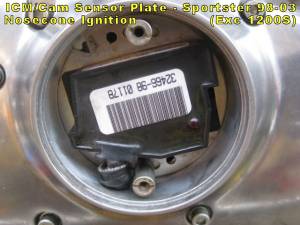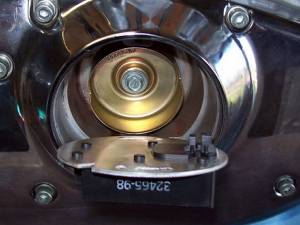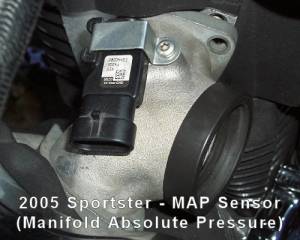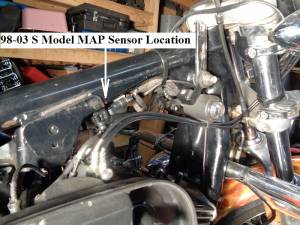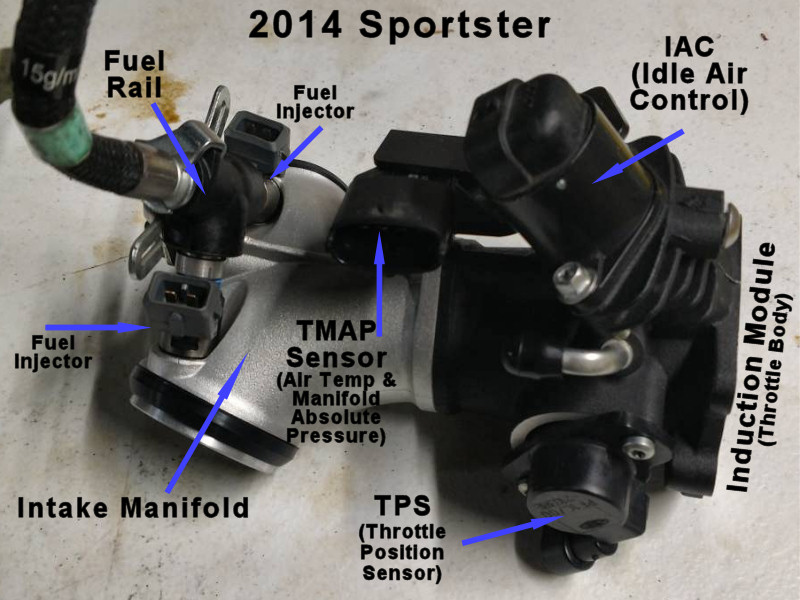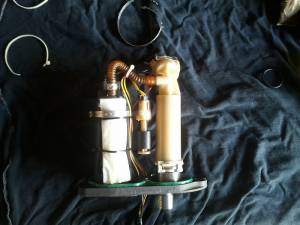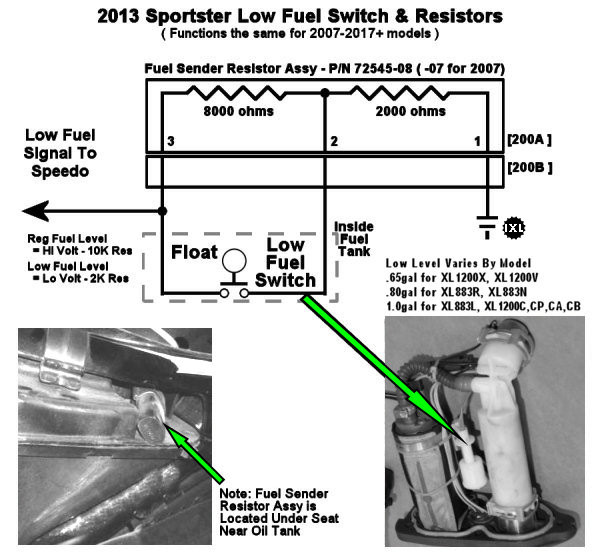Table of Contents
EVO: Engine Control
Electronic Fuel Injection System (EFI)
Sub Documents
The Electronic Fuel Injection (EFI) system was introduced on the Sportster models in 2007. It was modified and upgraded in 2014.
(2007-2013) The engine management system is designed around the Engine Control Module (ECM) along with a number of sensors and controls, such as the following:
- CKP - Crankshaft Position (CKP) Sensor
- MAP - Manifold Absolute Pressure (MAP) Sensor
- TMAP - Combined Intake Air Temperature (IAT) & Manifold Absolute Pressure (MAP) Sensor
- TPS - Throttle Position Sensor
- IAC - Idle Air Control
- ETS - Engine Temperature Sensor
- O2S - Oxygen Sensors
- VSS - Vehicle Speed Sensor
- TSM/TSSM - Turn Signal (Security) Module w/internal Bank Angle Sensor (BAS)
- JSS - Jiffy Stand Sensor (on international models)
- Dual-encapsulated Ignition Coils
A Serial Data Bus (SDB) is implemented to communicate between the ECM, the TSM/TSSM and the Speedo/Tach devices.
The ECM computes the spark advance for proper ignition timing based on sensor inputs from CKP, TMAP and TPS sensors, and regulates the low-voltage circuits between battery and ignition coil.
The ECM contains all of the solid state components used in the ignition system. The dwell time for the ignition coil is also calculated in the microprocessor and is dependent upon battery voltage. The programmed dwell gives adequate spark at all speeds.
The ECM has protection against transient voltages, continuous reverse voltage protection, and damage due to jump starts. It is fully enclosed to protect it from vibration, dust, water or oil.
The CKP sensor generates an AC signal which is sent to the ECM where it is used to reference engine position (TDC) and speed. It functions by taking readings off the 32minu2 teeth on the left side flywheel (two teeth are missing to establish a reference point).
The TMAP sensor is located on top of the intake manifold. The TMAP sensor monitors the intake manifold pressure (vacuum) and intake air temperature and sends the information to the ECM where the module adjusts the spark timing and fuel curve for optimum performance.
The BAS (within the TSM/TSSM/HFSM) monitors the bike for tip overs. If detected, the engine will be shut off. Once the sensor is tripped, the motorcycle must be uprighted, turned off and then on again before the engine can be restarted.
The dual-encapsulated coils (for front & rear cylinders) fire each spark plug independently - one cylinder at a time - no wasted spark.
The ignition system gives a spark near top dead center for starting. At RPM and loads above this, the system gives a spark advance that varies between 0 and 50.
The IAT, ETS, TPS and O2S sensors are used to provide information to the ECM to fine tune spark and fuel delivery. The VSS is used as an input for idle speed control. The oxygen sensors monitor the exhaust gas for oxygen content. The air/fuel mixture is then adjusted to maintain an optimal air/fuel ratio.
(2014-later)
\\ ===== Engine Sensors (Carb & EFI) =====
This chart shows the sensors & devices used in various years/models. The devices themselves varied over the years so this chart DOES NOT show inter-year compatibility of parts.
| CamPos | CKP | Other Devices | VSS | BAS | Notes | |
|---|---|---|---|---|---|---|
| 1986-2003 Exc S | X | VOES-Only | 1995+ | 1998+ | 12v VSS direct to Speedo & BAS on Battery Case |
|
| 1998-2003 S Model | X | MAP-Only | X | X | ||
| 2004-2006 Carbed | X | MAP-Only | X | X | 5v VSS to ICM/ECM & BAS in TSM/TSSM |
|
| 2007-later EFI | X | TMAP·ETS·TPS·O2S·IAC·FuelInj | X | X |
Default values of sensors during Hot Idle - as read using the Digital Technician software. 1)
| 2007 Example of Default Values of Scanned Data | ||||
|---|---|---|---|---|
| Checked Item | Min Value | Max Value | Hot Idle Value | |
| TMAP Sensor | MAP | 10kPa | 104kPa | 10.3-13.3 in. Hg 34-45kPa |
| 0.0v | 5.1v | 1.5-3.0v | ||
| IAT | 3°F (-16°C) | 248°F (120°C) | 104-140°F (40-60°C) |
|
| 0.0v | 5.0v | 2.0-3.5v | ||
| TP Sensor | 0% | 100% | 0% | |
| 0.2v | 4.5v | 0.2-1.0v | ||
| IAC Pintle | 0 | 155 | 20-50 steps | |
| RPM | 800 | 5600 | 1000 | |
| ET Sensor | 3°F (-16°C) | 464°F (240°C) | 230-300°F (110-150°C) |
|
| 0.0v | 5.0v | 0.5-1.5v | ||
| INJ PW Frt/Rr | 0ms | 50ms | 2-4ms | |
| O2 Sensor Frt/Rr | 0.0v | 5.0v | Quickly Fluct. 0.0-1.0v* |
|
| Timing Adv F/R | 0° | 50° | 10-15° | |
| VSS | 0mph | 120mph | 0mph | |
| Battery Volts | 10v | 15v | 13.4v | |
| Engine Run Mode | off | RUN | RUN | |
| Idle RPM | 800 | 1250 | 1000 | |
| Hot Idle = Engine temp 260° at 1000 RPM with stock exhaust | ||||
| * Not included in original table - taken from EDM section 4.21 | ||||
Sensor Power - 5 volts
Starting with the 1998 Sport Model, some of the sensors required a 5-volt power supply. This was accomplished by the Ignition Control Module (or later, the Engine Control Module) converting the normal 12-volt system power to a 5-volt power level that is supplied to some sensors. The table below shows how to track down the 5-volt connections & the potential ground connections that might create issues or cause Diagnostic Codes to be set. If a problem is indicated, you can check the information related to the individual sensors further down the page. 2)
| 1998-2003 Sport Model Only |
|---|
| Start at the ICM (RED/White wire) on Gray Connector Pin-1 This is +5v Output from the ICM as Sensor Power Supply. Check for +5v at: Cam Position Sensor (RED/White wire) on Connector 14B Pin-A MAP Sensor (RED/White wire) - Connector 80B Pin-C Check ICM Gray Connector Pin-8 for Sensor Ground – Be sure it is equal to Battery Negative Check ICM Black Connector Pin-2&11 for ICM Ground Check ICM Black Connector Pin-1 for Switched 12v Power (RUN/STOP SWITCH) |
| 2004-2006 (Serial Data Bus) |
| Start at the ICM (RED/White wire) on Connector Pin-3 This is +5v Output from the ICM as Sensor Power Supply. Check for +5v at: VSS (BLACK/Red wire) on Connector 65B Pin-1 (might be RED/White wire) MAP Sensor (RED/White wire) - Connector 80B Pin-C Check ICM Connector Pin-4 for Sensor Ground – Be sure it is equal to Battery Negative Check ICM Connector Pin-5 for ICM Ground Check ICM Connector Pin-1 for Switched 12v Power (RUN/STOP SWITCH) Check ICM Connector Pin-2 for 12v Battery Power |
| 2007-2013 (Serial Data Bus) |
| Start at the ECM (RED/White wire) on Connector Pin-14 This is +5v Output from the ECM as Sensor Power Supply to: Engine Harness (R/W wire) on Connector 145A/B Pin-5 Check for +5v at: VSS (R/W wire) on Connector 65B Pin-A TMAP Sensor (R/W wire) - Connector 80B Pin-C TPS Sensor (R/W wire) - Connector 88B Pin-B Jiffy Stand (R/W wire) on Connector 133B Pin-1 – Even if not HDI model, this connector can be an issue Check ECM Connector Pin-26 for Sensor Ground – Be sure it is equal to Battery Negative Check ECM Connector Pin-10 & Pin-28 for ECM Ground Check ECM Connector Pin-13 for Switched 12v Power Check ECM Connector Pin-31 for 12v Battery Power |
| 2014-later (CANbus) |
| Start at the ECM (RED/White wire) on ECM Connector-2 Pin-9 This is +5v Output from the ECM as Sensor Power Supply to: Engine Harness (R/W wire) on Connector 145A/B Pin-8 Check for +5v at: VSS (R/W wire) on Connector 65B Pin-A TMAP Sensor (R/W wire) - Connector 80B Pin-3 TPS Sensor (R/W wire) - Connector 88B Pin-B Jiffy Stand (R/W wire) on Connector 133B Pin-1 – Even if not HDI model, this connector can be an issue Check ECM Connector 1&2 Pin-10 as both Sensor Ground & ECM Ground – Be sure it is equal to Battery Negative Check ECM Connector-2 Pin-16 for Switched 12v Power Check ECM Connector-2 Pin-18 for 12v Battery Power |
CPS - Cam Position Sensor
1986-1997 All Models & 1998-2003 'S' Models
These models use a Cam Position Sensor (CPS) Plate that is separate from the Ignition Control Module (ICM).
The Cam Sensor is a Hall-effect device mounted on the Cam Sensor Plate. It is used in conjunction with a rotor 'cup' mounted to the end of the camshaft. As the cup rotates, it passes through the Cam Sensor. Slots in the cup walls are 'timed' to the engine, allowing the cam sensor to indicate to the ICM the position of the cam shaft, and therefore, the position of the crankshaft. This information is used to time the firing of the spark plugs.
The CPS connects thru the main wire harness to the ICM. It uses a 3-pin connector, known as 14A/B. It is located under the engine (left side near the kick stand). The 14A (plug) comes from the CPS Unit - the 14B (socket) is on the main harness and goes to the ICM.
The Cam Sensor Plate is used to set the base timing of the engine, from which the ICM will advance or retard the spark according to its determined needs. See the Ignition Timing information in the Sportsterpedia.
The 1980-1993 models use CPS P/N 32400-80B (current superceding P/N) and the 1994-1997 (and 1200S models, 1998-2003) use CPS P/N 32400-94A (current superceding P/N). (You can test fire the ICM from this connector: See Here.)
On Connector 14B (3-pins), the wires function as follows:
- Pin(A) Red/White - 12v Power from ICM to Cam Sensor - 5v power for 1998-2003 'S' Models 3)
- Pin(B) Green/White - Rotor Signal from Cam Sensor to ICM
- Pin(C) Black/White - Ground from ICM to Cam Sensor
These diagrams show the CPS mating connector on the Main Harness:
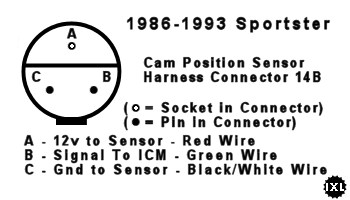 4)
4) 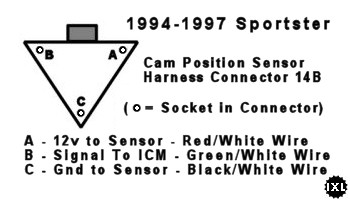 5)
5)
(Note: the 1998-2003 Sport model uses the same Cam Sensor & Connector as the 1994-1997 models. The slotted rotor cup is different on the Sport models, having additional slots to allow for the single-fire ignition. Note also, with the new ICM module and the addition of a MAP Sensor, the power to the CMP Sensor is 5v (also to the MAP Sensor) for the 1998-2003 'S' models.)
Testing the Cam Sensor
You can test the Cam Sensor by inserting a stick pin or needle in the backside of Pin(B) on connector 14A while it is still connected together with 14B (to obtain power). Then connect your multimeter RED probe onto the pin/needle placed in Pin(B) and your BLACK meter probe on a solid ground point. Pull the spark plugs (so the engine turns easily but won't start) and turn the keyswitch on. Then use the starter button to bump (rotate) the engine.
When the engine is rotated, the slotted cup rotor (in the 'nosecone') on the end of the camshaft will pass thru the cam sensor creating an alternating output on Pin(B). Since the sensor has a 12v power source, the measured voltage is predicted to be from below 2v to above 10v, alternating.
Being in an enclosed area (nosecone) of the engine, the Cam Sensor is subject to high temperatures. The potting material is subject to melting and may cause erratic timing. (This location for the Ignition Module on the 1998-2003 models also created high heat failure issues for the module.)
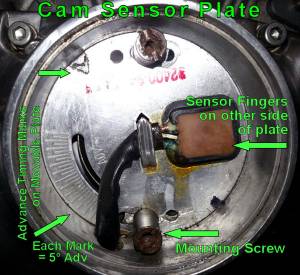 1986-1993 All Models - 32400-80B Sensor Plate 1994-1997 All Models - 32400-94A Sensor Plate | 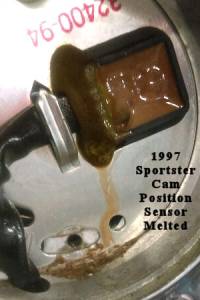 6) </sup> 6) </sup> 1997 Cam Position Sensor Melted |
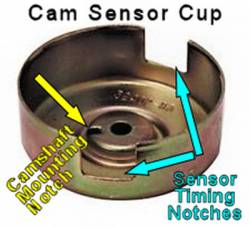 32402-83 Rotor Cup Used in 1986-1997 All Models Also 1998-2003 Models except 1200S | 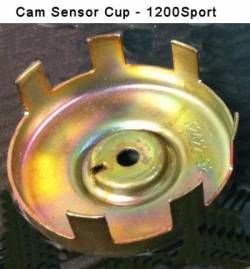 7) </sup> 7) </sup> 1998-2003 1200S - 32422-98 Rotor Cup |
1998-2003 Not-Sport Models
All models in 1998-2003, except the Sport Model, had the Ignition Control Module (ICM) incorporated onto the Cam Sensor Plate. The combined function was located in the timing cavity known as the nosecone, just where the Cam Sensor Plate was previously located alone.
The new ICM/Cam Sensor Plate still operated the same way - There was a sensor on the back side of the plate - The sensor monitored a rotating cup mounted on the end of the cam - It had windows cut into the cup to create the spark timing for the ICM.
This design was problematic due to the high-heat location of the electronics. Due to the high failure rate, the MoCo did not continue the design nor a supply of stock replacement units. The only source for replacing a failed 1998-2003 nosecone ICM has been the aftermarket. (See the REF section regarding the Ultima Ignition Module.)
In 2004 and later models, the Cam Position Sensor was replaced by using a Crankshaft Position Sensor (CKP) instead.
CKP - Crankshaft Position
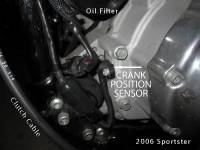 The CKP sensor (first used with the 2004 rubbermount models) is located in the front left side of the crankcase. It functions in place of the nosecone cam position cup & sensor plate.
The CKP sensor (first used with the 2004 rubbermount models) is located in the front left side of the crankcase. It functions in place of the nosecone cam position cup & sensor plate.
The CKP sensor is a variable reluctance device that generates an AC voltage. This signal is sent to the ECM where it is used to reference crankshaft position, phase (front TDC compression stroke) and engine rpm. It functions by taking readings off the 30 teeth on the left side flywheel (32-tooth positions, but two teeth are missing to establish the front TDC reference point). The ECM uses the slowing down of the crankshaft on the compression stroke to determine phasing, therefore, the plugs should be installed when checking for ignition spark (use an extra plug to check spark).
Take Note: If the CKP signal is missing or distorted or too weak, the ECM will prevent the ignition & fuel injectors from firing, thus preventing engine operation.
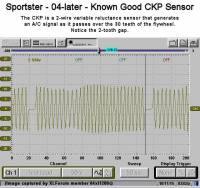 Testing/Troubleshooting 8) Disconnect the electrical connector (front left-side of crankcase) for the CKP Sensor.
Testing/Troubleshooting 8) Disconnect the electrical connector (front left-side of crankcase) for the CKP Sensor.
(A) Check resistance between each lead of the CKP sensor and ground - Each side should be more than 1-megohm of resistance. (B) Set your meter to Volts-AC (⇐20v) and connect across both leads of the CKP Sensor - Crank the engine for about 5 seconds - You should read a minimum of 1v-AC on the CKP Sensor leads. Turn off power. (C) Keep your meter connected to the sensor connector - Set your meter to Ohms - Between the two leads, you should read 600-1200 ohms. RESULT If any test fails - remove the CKP sensor from engine, clean any debris from sensor, reinstall properly - Recheck your results - If the unit still fails (especially if no voltage), replace the CKP. 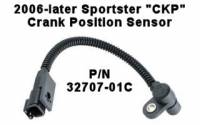 See this __XLForum Thread__.
See this __XLForum Thread__.
NOTE1: The CKP P/N for 2004-2005 models is currently 32804-04B (long cable). The CKP P/N for 2006-2017+ models is currently 32707-01C (short cable), which is also used on some BT models.
NOTE2: With the CKP DTCs being a recurring issue, it would be a good idea to open & clean the CKP to main harness connector located beneath the frame. Put dielectric grease in the connector to help keep out grit & grime, then reconnect it. It may be getting excessive contamination due to its location.9)
NOTE3 DTC P0373 & P0374 Diagnostic Tips - Engine must crank for at least five seconds (without CKP signal) in order to set P0374 code. Intermittent TMAP wiring or sensor issues may cause these codes to set prior to setting TMAP codes. Verify TMAP wiring and sensor.
NOTE4: You may also need information regarding how the CKP is used for Spark Signal Syncronization and Engine Phase (see this Sportsterpedia page: http://sportsterpedia.com/doku.php/techtalk:evo:engctl01#single-fire_spark_synchronization_2004-later).
MAP - Manifold Absolute Pressure
(Used on 1998-2003 Sport models & all 2004-2006 models)10)
The Manifold Absolute Pressure (MAP) sensor was introduced on the 1998-2003 Sport models and was then used on all 2004-2006 models. These are carburetored models. The MAP sensor for 98-03 Sport models is mounted on a bracket (sticky taped to the right frame tube) under the tank. The MAP sensor on 04-06 models is mounted on the intake manifold which distributes the incoming air/fuel mixture from the carburetor into the two cylinders. It replaced the older VOES function which operated using a vacuum hose from the carburetor (described here). The 2007-later models used a combined TMAP sensor that included both an IAT Sensor & a MAP Sensor - see the TMAP section.
The MAP sensor has three leads. One is supplied with +5v from the Ignition Control Module (ICM), one is the ground and the third is a signal back to the ICM. The MAP sensor provides information to the ICM to alter the timing of the spark based on the current vacuum conditions in the manifold. Under varying barometric pressures & engine load conditions, which alters the vacuum level in the intake manifold, the information from the MAP sensor allows the ICM to alter the timing to create better combustion. The barometric pressure is influenced by weather and altitude.
The MAP Sensor, in accordance with the changing engine vacuum and atmospheric barometric pressure, alters the voltage sent back to the ICM - more vacuum equals lower voltage. See the 98-03 1200S MAP sensor location in the middle 11) & 04-06 MAP Sensor Location to the right —→.12) Measure voltage related to the MAP sensor 13)
With key ON, engine OFF, voltage sent to the MAP sensor by the ICM should be 5.0 volts.
With key ON, engine OFF, voltage sent to the ICM must be between 4.2 and 4.95 volts.
With key ON, engine running, voltage sent to the ICM must be between 1.5-3.0 volts at hot idle (1000rpm).
| DTCode | Trouble Condition |
|---|---|
| P0106 | will set if the MAP sensor signal fluctuates faster than normal operation |
| P0107 | will set if the MAP sensor has a faulty connection or is disconnected |
| P0108 | will set if the MAP sensor signal is shorted high - as to the input voltage |
To test that P0107 occurs, disconnect the MAP sensor & turn the key on - check the DTCs.
To test that P0108 occurs, disconnect the MAP sensor, then short socket Pin# B to socket Pin# C of the harness connector# 80B (be sure not to touch Pin# A) - Then turn the key on - check the DTCs.
This XLForum thread lists some test info & alternative part numbers: https://www.xlforum.net/forum/sportster-motorcycle-forum/sportster-motorcycle-general-discussion-and-problems/121908-map-sensor-warning-id10t-type-of-question?threadid=1195745
(HD # 32316-99 changed to 32417-10)
(Alternatives: Delphi# PS10002 / Echlin# 216451 / Delco# 213-331 / GM# 12614970 / GM# 16212460)
See also Testing the Map Sensor Operation under the TMAP section below.
EFI Manifold & Induction Module
Fuel Injectors
The fuel injectors (see pic above) are electrical solenoids (switch valves for liquid) that allow the flow of pressurized fuel from the electric fuel pump. The injectors spray fuel (like a hose nozzle) into the intake manifold air tract.
The injection time (therefore, fuel amount) is a matter of how long (in milliseconds) the injector solenoid is active. This is a very small time period controlled by the ECM. The injectors are timed by the ECM to inject fuel a the proper time during the engine cycle. The injectors are triggered individually for the front & rear cylinder intake.
When the engine is operating, the ECM controls the path to ground for the injectors (solenoids) to trigger the injection of the appropriate amount of fuel (to meet the Air-Fuel-Ratio goals) at the proper time. Power is supplied to the injectors thru the system relay so that they can be turned off with the rest of the ignition components (the fuel pump and ignition coil).
| DTCode | Trouble Condition |
|---|---|
| P0261 | Front Injector open/low |
| P0262 | Front Injector high |
| P0263 | Rear Injector open/low |
| P0264 | Rear Injector high |
Test the injector solenoid by measuring resistance between the two connector pins. It should read 10.0 - 25.0 ohms.
To test the injectors for leaking fuel into the manifold:
- Remove the air cleaner
- With the throttle wide open, turn key ON for 2 seconds and then OFF for 2 seconds five consecutive times.
- Replace the fuel injector if there is any evidence of raw fuel in the bores.
To help in verifying the injectors are being triggered, since the pulses are very small, there are diagnostic sets called Noid Testers to help show that a pulse has been received. Tester sets come with various connectors to allow the Noid Tester to be used on fuel injectors, intake air controls and even on coils.
IAT - Intake Air Temperature
See TMAP Sensor
TMAP - Temperature/Manifold Absolute Pressure
The TMAP sensor (used on 2007-later models - see pic above)16) combines an IAT (Intake Air Temperature) and a MAP (Manifold Absolute Pressure) sensor into a single component. It is mounted on the intake air manifold which distributes incoming air from the throttle body into the two cylinders.
The TMAP sensor provides information to the ECM upon which the ECM alters the timing of the spark and the injection of fuel based on the current vacuum conditions in the manifold. By altering the spark timing and fuel, better combustion occurs in varied situations.
The MAP Sensor
The MAP on 1998-2003 Sport models only and 2004-2006 Models Sportsters is a stand alone unit. Function and testing is the same as in 2007 models below.
The MAP Sensor Signal from the TMAP Sensor
- The MAP sensor monitors the changing vacuum (pressure) in the manifold that occurs as you ride, change speeds and vary the engine load via the throttle position. The MAP signal (in the ECM) is temperature compensated and uses a complex algorithm to help offset the pulsating wobble effect of the HD V twin's assymetrical firing setup.
- It is a very major component of the final speed density calculation that ulimately determines the injector's pulse width required to sustain the best A/F ratio at any given time.
- There are several codes that it can throw out such as:
| DTCode | Trouble Indicated |
|---|---|
| 1998-2003 S-Models 17) | |
| Code 12 | MAP Out Of Range or Fluctuates Faster Than Normal |
| 2004-Up Models | |
| P0106 | MAP Sensor Rate-Of-Change Error |
| P0107 | Map Sensor Open/Low |
| P0108 | Map Sensor High |
- The P0106 will set if the MAP sensor signal fluctuates faster than normal operation. 18)
- The P0107 indicates that the reading was either absent or fell below the minimum range for some period of time. If not calibrated correctly or working properly the ECM will assign a canned value and use the other inputs to adjust the A/F ratio. It will greatly affect your richness/leaness if it is skewed or not registering accurate readings.
TESTING the MAP SENSOR 19)
The signal varies in accordance with engine vacuum and atmospheric barometric pressure. Changes in barometric pressure are influenced by weather and altitude.
Bypassing the MAP for Testing: 20)
- With the MAP sensor disconnected, the ignition control module should recognize a low voltage. If low voltage is observed, the ignition control module and harness are not at fault.
- You can gently place a jumper wire across the MAP Sensor connector power and feed terminals. With the jumper in place, the ignition control module should recognize a high voltage.
MAP Output Voltage:
- This requires a digital multimeter set to the 0-20 volt DC setting, MAP connected inline (and optional Mityvac or other hand held vacuum pump).
See also MityVac Vacuum Pump Function and Usage in the Sportsterpedia.
* Typically most MAP sensors are simply a set of resistive strain guages mounted on a suitable substrate and forming a bridge circuit. 21)
- With the ignition switch turned to ON, test the leads as follows:
- (Input Power) Probe the R/W wire lead and verify it has +5 volts.
- (Signal Out) Remove the hose from intake manifold and if needed add an extension to it so you can easily apply a vacuum with the vacuum pump or your mouth.
- Draw up some vacuum while probing the V/W wire. The signal voltage should lower as the vacuum is applied (read between 1.5-3.0 volts).
Caution: Do not over-pump (or otherwise create too much vacuum) while checking the MAP sensor output as sensor damage may result. - Then release the vacuum slowly and see the voltage increase, confirming the output signal functions properly.
- This signal is the one that the ECM uses to assess the state of load on the engine relative to the Throttle Position Sensor and the CKP (RPM) signals.
The IAT Sensor in the TMAP Sensor
The Intake Air Temperature (IAT) portion of the TMAP sensor is a thermistor device. It has a power input (+5v), a ground and a signal back to the ECM. At a specific temperature, the IAT will have a specific resistance across its terminals. As this resistance varies, so does the voltage sent back to the ECM.
- At high temperatures, the resistance of the IAT sensor is very low, which effectively lowers the signal voltage.
- At low temperatures, the resistance is very high, allowing the voltage to rise close to 5 volts.
The ECM monitors this voltage to compensate for various operating conditions.
| IAT Table - Relationship of Air Temp to Resistance & Voltage | ||||||
|---|---|---|---|---|---|---|
| Temp °F | Ohms | Volts | Temp °F | Ohms | Volts | |
| -4 | 29121 | 4.9 | 104 | 1598 | 3.1 | |
| 14 | 16599 | 4.8 | 122 | 1080 | 2.6 | |
| 32 | 9750 | 4.6 | 140 | 746 | 2.2 | |
| 50 | 5970 | 4.3 | 158 | 526 | 1.7 | |
| 68 | 3747 | 4.0 | 176 | 377 | 1.4 | |
| 77 | 3000 | 3.8 | 194 | 275 | 1.1 | |
| 86 | 2417 | 3.6 | 212 | 204 | 0.9 | |
| Values for ohms & volts are +-20% | ||||||
TPS - Throttle Position Sensor
The Throttle Position Sensor (TPS) (see pic above) is mounted on the Throttle Body of 2007-later (EFI) models.22) - See example in the 'EFI Manifold & Induction Module' picture.
The ECM provides a +5 volt supply and ground to the sensor. The TPS sends a signal back to the ECM. The returned signal varies in voltage according to throttle position. The TPS operates as a variable resistance.
- At idle (closed throttle), the signal is typically in the range of 0.20 - 0.80 volts.
- At wide open throttle, the signal is normally 4.0-4.9 volts.
| DTCode | Trouble Condition |
|---|---|
| P0122 | TPS open / voltage low |
| P0123 | TPS high voltage |
Check the TPS Output Voltage Scaling
With the Key ON, engine not running, observe the TP sensor voltage at the ECM on the TPS input line while opening the throttle. Voltage displayed should vary from <1.0 volts (throttle closed) to greater than 4.0 volts (throttle held wide open). As the throttle is slowly moved, the voltage should change gradually without spikes or low voltages being observed. There was an upgrade to P/N 27629-01A after 2008 (not sure which year) that is compatible for all 2007-later models.
Note: If you hold the throttle open before starting the engine, and the TPS signal is equal to or greater than 3.8v, the system goes into a condition called 'clear flood' mode. The engine will not start because the fuel system is shut off, but the starter will operate and you will get spark. This may also occur if there is a mechanical problem, such as stuck throttle cables or seriously damaged TPS.
IAC - Idle Air Control
The EFI Sportsters (2007-later) include an Idle Air Control (IAC - P/N 27628-01A) (see pic above) to set the idle speed of the engine. The IAC is mounted on the throttle body.
In normal riding operation, the air flow into the engine, thru the intake manifold, is controlled by the opening and closing of the throttle plate in the throttle body, via the throttle cables. But, during idle conditions, the EFI system uses the ECM to control the IAC, which opens & closes an air pathway around the throttle plate to supply air into the manifold.
The Idle Condition, under which the IAC operates, is when the VSS is '0' (no vehicle motion) and the TPS value is less than 1% (throttle fully closed).
The IAC has a motor driven pintle (or pin/shaft/plug) that allows more air (when retracted) or less air (when extended) to bypass the throttle plate. The IAC motor is controlled by electrical pulses to either extend or retract the pintle, each pulse (step) moving the pintle a given distance. However, since the IAC has no feed back to the ECM to indicate its current position, changes in position are based on the ECM keeping track of where it last put the pintle.
When the keyswitch is turned off, the power to the ECM remains (coming from the ECM fuse, later the Battery fuse). The ECM performs a 10-second procedure to 'reset' the IAC. This 'reset' procedure should not be interrupted by turning the keyswitch back on. It will often be audible in the 10 second period after the key is turned off.
During the 'reset' procedure, the ECM will send enough pulses (defined in the ECM programming) to fully extend the pintle and completley close the air bypass. This is considered the '0' count position for tracking the pintle position. The '0' count position is only used for synchronization and is not a normal position at any time other than during the reset procedure.
To complete the 'reset' procedure, the IAC is given a number of predefined pulses (steps) to open it (retract) to a 'parked' position. The ECM assumes that the pintle is in this position during the next start procedure. At a restart, the ECM begins tracking the pintle position thru the pulse count tracking.
This parked position of the pintle allows an increased air flow (and therefore idle speed) in preparation for the next startup operation.
| DTCode | Trouble Condition |
|---|---|
| P0505 | Loss of Idle Speed Control |
This code may occur under various conditions and along with other DTCs. Resolve the other codes first before addressing the P0505.
A P0505 DTC is set if, during an Idle Condition, the idle RPM is 200 above the programmed idle speed and the IAC motor is at a '0' position count (fully closed) for greater than 5 seconds or if the idle RPM is 200 below the programmed idle speed and the IAC motor is at its maximum position count (fully open) for greater than 5 seconds. Some failures that might create this condition are:
- if an intake manifold air leak is large enough to cause the IAC to reset to '0' position while the ECM is attempting to control the idle speed.
- if the fuel injectors are leaking extra fuel into the manifold bypassing the EFI control and raising the engine RPM.
- if there is a defective TPS reporting an incorrect throttle plate position.
- if there is a defective ETS reporting an incorrect engine temperature.
Other conditions that might set a P0505 code are related to engine misfires, a vacuum leak, contaminated fuel or wet sumping.
The IAC Pintle moves from fully closed to fully open with a maximum of 155 pulses. The typical pulse count (open) during Hot Idle is between 20 & 50.
The IAC will give up its control of the engine when it is not in an Idle Condition - meaning that the TPS voltage exceeds 1% (the throttle is open) or the VSS becomes greater than 0 (the bike is moving). It will not have control if the battery voltage drops below 9.0v. If the Battery Voltage connection to the ECM is lost, the engine will start, but the IAC will not be able to perform the reset procedure when the keyswitch is turned off because the ECM will not have power. Eventually, the pintle position tracking will fail causing performance problems.
A number of riders have reported a High Idle problem that occurs when coming to a stop. Sometimes the P0505 DTC is set, but not always. This XLForum thread discusses that issue: https://www.xlforum.net/forum/sportster-motorcycle-forum/sportster-motorcycle-era-specific-and-model-specific/efi-sportster-motorcycle-talk-2007-and-up/90800-throttle-idle-problem-newbie?t=737008)
ETS - Engine Temperature Sensor
The Engine Temperature Sensor (ETS) is a thermistor device used on 2007-later (EFI) models. The ECM provides a voltage on its signal line and monitors how that voltage is affected by the varying resistance of the ETS. At a specific temperature, the ETS will have a specific resistance across its terminals. As this resistance varies, so does the voltage seen by the ECM.
- At high temperatures, the resistance of the IAT sensor is very low, which effectively lowers the signal voltage.
- At low temperatures, the resistance is very high, allowing the voltage to rise close to 5 volts.
The ECM monitors this voltage to compensate for various operating conditions, including using the ETS input as a reference for changing the IAC pintle position.
| ETS Table - Relationship of Engine Temp to Resistance & Voltage | ||||||
|---|---|---|---|---|---|---|
| Temp °F | Ohms | Volts | Temp °F | Ohms | Volts | |
| -4 | 98936 | 4.9 | 140 | 2470 | 1.9 | |
| 14 | 56102 | 4.8 | 158 | 1739 | 1.5 | |
| 32 | 32957 | 4.5 | 176 | 1246 | 1.2 | |
| 50 | 20000 | 4.3 | 194 | 907.7 | 0.9 | |
| 68 | 12511 | 3.9 | When The Engine Is Hot, The ECM | |||
| 77 | 10000 | 3.6 | Changes The Voltage Scale (Below) | |||
| 86 | 8045 | 3.4 | 176 | 1246 | 4.0 | |
| 104 | 5304 | 2.9 | 194 | 907.7 | 3.7 | |
| 122 | 3577 | 2.4 | 212 | 671.2 | 3.4 | |
| Values for ohms & volts are +-20% | ||||||
To help with accurate measurements, the ECM changes the voltage supplied to the ETS once the engine becomes hot. Therefore, the same resistance in the ETS is seen as a higher voltage as shown in the table.
O2S - Oxygen Sensor
| DTCode | Trouble Condition |
|---|---|
| P0131 | Front O2 Sensor - low or engine running lean |
| P0132 | Front O2 Sensor - engine running rich |
| P0134 | Front O2 Sensor - high/open/not responding |
| P0151 | Rear O2 Sensor - low or engine running lean |
| P0152 | Rear O2 Sensor - engine running rich |
| P0153 | Rear O2 Sensor - high/open/not responding |
A voltage reading of 5v on the O2 Sensor output is typical for a cold engine. Once the O2 sensors are up to operating temperature, typical voltage is 0.45 volt (approximately 14.6 AFR).
The O2 sensor DTCs WILL NOT set the Check Engine Light. Current DTCs can be retrieved thru the speedometer display and the historic codes thru computer-based diagnostic tools.
VSS - Vehicle Speed Sensor
The VSS is a hall-effect device located on the engine, just above the sprocket cover and near the rear of the starter solenoid.
The sensor output is varied by proximity to the teeth on the 5th gear in the transmission. This is the final output gear
in the transmission & rotates the final drive sprocket (belt) at the same rpm.
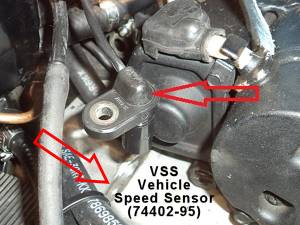 (1995-2003) (1995 = P/N 74421-95 - 1996-2003 = P/N 74402-95)
(1995-2003) (1995 = P/N 74421-95 - 1996-2003 = P/N 74402-95)
The VSS is a 12v-based hall-effect sensor. The 12v power source is supplied by the speedometer on the RED wire, the BLACK wire is ground and the WHITE wire is the pulsing signal sent directly to the speedometer.
Because the external final drive ratio may vary by model (883 vs 1200), the speedometers are different for different models because they must internally account for the difference in final drive ratios. The following chart shows the VSS pulses to produce various speedometer readings. The 1996 change accounts for the High Contact Ratio (HCR) Gears implemented that year. 23)
| Pulses per Second from VSS - Produces Speed Shown on Speedometer | |||||
|---|---|---|---|---|---|
| Year - Model | 20mph | 40mph | 60mph | 80mph | Notes |
| 1995 - 883 | 345 | 687 | 1026 | 1361 | |
| 1200 | 321 | 640 | 955 | 1268 | |
| 1996 - 883 | 439 | 874 | 1306 | 1733 | HCR Gears |
| 1200 | 408 | 814 | 1216 | 1613 | HCR Gears |
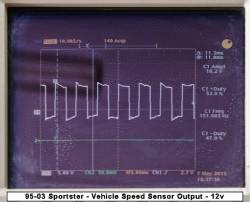 Troubleshooting - For models from 1998-2003, you should check your speedometer for Diagnostic Codes to see if there is an indication of a faulty sensor reading. If you are experiencing erratic speedometer readings, removing and cleaning the sensor should be done to obtain a clean signal.
Troubleshooting - For models from 1998-2003, you should check your speedometer for Diagnostic Codes to see if there is an indication of a faulty sensor reading. If you are experiencing erratic speedometer readings, removing and cleaning the sensor should be done to obtain a clean signal.
The sensor output is a square-wave which varies from 'less than 3v' (when at a tooth) to 'greater than 6v' (at a gap). A multimeter on a low DC scale should be able to observe this output on the WHITE wire of the sensor when manually rotating the engine in 5th gear - power on, but spark plugs removed.
If you are able to observe the above voltages from the sensor, but the speedometer is still erratic or otherwise malfunctioning, be sure to test all the wiring between the sensor and the speedometer. As a last resort, replacement of the speedometer may be in order.
See this Sporsterpedia SubDoc for a discussion about the VSS / Speedometer / TSM signals.
Check this XLForum thread for a 'FIX' to erratic speedo operation for 1995-2003 models.
(2004-2013) (2004 only = P/N 74402-04A - 2005-2013 = P/N 74402-05B)
The VSS is a 5v-based hall-effect sensor. The 5v power source for the sensor (BLACK/RED wire of the twisted pair) comes from the ICM/ECM and the pulsing output from the sensor (BLACK/BLUE wire of the twisted pair) goes to the ICM/ECM for processing. The ground connection (BLACK wire) is part of the main harness.
Internally, the ICM/ECM calculates the appropriate speed information and sends that information to the speedometer and the TSM over the Serial Data Bus. Since the ICM/ECM makes the calculations, the speedometer and TSM do not have to account for any variations.
Troubleshooting - Check your speedometer for Diagnostic Codes to see if there is an indication of a faulty sensor reading.
The sensor output is a square-wave which varies within the 0v to 5v range, depending on the proximity to a tooth. The middle pin of the connector is the output and is, typically, the BLACK/BLUE wire. A multimeter on a low DC scale should be able to observe this output variation when manually rotating the engine in 5th gear - power on, but spark plugs removed.
If you are experiencing erratic speedometer readings, removing and cleaning the sensor should be done to obtain a clean signal.
If you are able to observe the above voltage variations from the sensor, but the speedometer is still erratic or otherwise malfunctioning, be sure to test all the wiring between the sensor and the ICM/ECM as well as the Serial Data Bus connection. As a last resort, replacement of the VSS or the speedometer may be in order.
(The 74402-04A sensor has a long attached cable while the later 74402-05B has a connector built on the sensor with the wiring being part of the main harness.)
(2014-on) (P/N 74402-05B)
The VSS sensor is the same 5v-based hall-effect sensor as for 2013 models and the ECM (Engine Control Module) handles all the processing of the signals. The ECM now utilizes the new CANbus to send the calculated data to the speedometer.
Note this very informative __XLForum Thread__ regarding the VSS.
BAS - Bank Angle Sensor
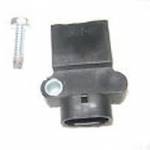
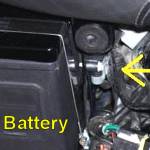 24)
24) 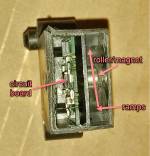 25)
25)
The Bank Angle Sensor, as an individual, external component, was used on Sportsters from 1998 to 2003. Using an internal v-shaped channel and steel ball, it is intended to kill the ignition if the bike lean angle exceeded 55 degrees, such as in an accident or tip over. It is attached upright, on those models, to the side of the battery box, toward the rear, using a locating pin and one screw. It must be mounted upright to operate properly. It has a 3-wire connector.
To reset the ignition function after the BAS has been triggered, turn off the keyswitch, set the bike upright, turn the keyswitch on.
The sensor can be tested while the bike is running, by placing a magnet at the top of the sensor. If the ignition stops, the sensor is working.
The sensor is sometimes unreliable, either failing to allow the bike to start or by not shutting down on tipover. Some have chosen to bypass the unit in order to eliminate the potential failure. See this section of the Sportsterpedia: bas_bypass_mod
Typical voltage on the BAS signal line when operating normally is 0.6v to 1.1v. When in a tipover condition, the signal line voltage is between 3.0v & 6v.26)
1998-2003 1200S models can detect an out-of-range error (Code 44) if the sensor line is shorted high or low.
For 2004-2013, the bank angle function is included inside the Turn Signal Module (TSM/TSSM).
For 2014-later, the BAS functions & the TSM/TSSM functions were incorporated into the Body Control Module (BCM).
Oil Pressure Switch
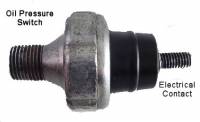 The Oil Pressure Switch is located at the Oil Filter mount. It is a pressure-actuated diaphragm-type switch that indicates a lack of oil pressure. The switch grounds the sensor wire when there is insufficient oil pressure to open the switch and causes the oil light to illuminate on the indicator bar or the speedometer.
The Oil Pressure Switch is located at the Oil Filter mount. It is a pressure-actuated diaphragm-type switch that indicates a lack of oil pressure. The switch grounds the sensor wire when there is insufficient oil pressure to open the switch and causes the oil light to illuminate on the indicator bar or the speedometer.
If the idle speed should fall below 1000rpms, the light may activate as a warning.
Neutral Indicator Switch
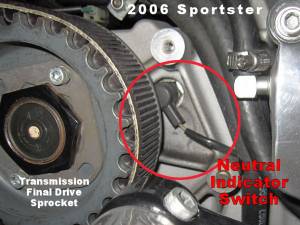
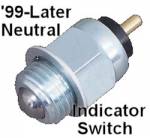 The Neutral Indicator Switch is located forward of the main drive gear shaft on the right crankcase half, partially behind the final drive tranmission sprocket. A pin on the transmission shifter drum contacts the switch plunger to indicate a neutral position of the transmission. The switch grounds the sensor wire causing the neutral indicator lamp to light (on the indicator bar or in the speedometer).
The Neutral Indicator Switch is located forward of the main drive gear shaft on the right crankcase half, partially behind the final drive tranmission sprocket. A pin on the transmission shifter drum contacts the switch plunger to indicate a neutral position of the transmission. The switch grounds the sensor wire causing the neutral indicator lamp to light (on the indicator bar or in the speedometer).
The sensor cannot be removed for replacement without removing the transmission final drive sprocket.
On EFI models (2007-later) the Neutral Indicator Switch is also utilized to prevent starting the engine if the bike is not in neutral and the clutch lever is not engaged.
Clutch Switch
Starting in 2007, the Clutch Lever had a switch implemented to allow it to be monitored.
The Clutch Switch and the Neutral Indicator Switch are monitored to assess whether to allow the starter relay to function. If the clutch lever is released & the transmission is not in neutral, the TSM/TSSM/HFSM (2007-2013) or the BCM (2014-later) will not provide the necessary ground for the relay coil to activate (even though the power is being supplied by the starter button/switch).
This is to prevent the bike from lurching forward when attempting to start it.
Jiffy Stand Switch (HDI only)
Starting in 2008, the International models have a Jiffy Stand Sensor (JSS) which utilizes a 3-wire Hall effect sensor to monitor the position (up or down). The ECM provides a +5v supply to the JSS and a return line to the ECM provides the status of the stand. The sensor is grounded to the Powertrain Ground Point. The domestic models have the same wiring, but no sensor is implemented.
When the jiffy stand is fully retracted the sensor picks up the presence of the metal tab mounted to the jiffy stand (providing less than 2v on the signal line). The metal tab is moved away from the sensor as the jiffy stand is extended (providing 4v or more on the signal line).
When the jiffy stand is extended, the engine will start and run only if the TSM/TSSM senses the transmission is in neutral. Otherwise, the engine will start and then simply stall.
The jiffy stand sensor also has a 'Fail Enable' mode. This mode allows the engine to start and run if the system recognizes a problem with the jiffy stand sensor circuit. If a problem exists or if the transmission is put in gear with the jiffy stand extended the odometer will display “SIdE Stand”.
(Here is an XLForum THREAD that discusses an intermittent issue which causes the bike to stop running and may not produce any DTC.)
Electric Fuel Pump (EFI)
Sub Documents
Fuel Pump Operation
Starting in 2007 (EFI), the Sportsters use an electric fuel pump. The fuel pump delivers fuel, under pressure, to the injectors. The pressure regulator, internally mounted on the fuel filter, controls the amount of pressure in the system. Excess fuel flow is bypassed from the pump assembly back into the fuel tank through the pressure regulator.
The fuel pump delivers fuel through the fuel line, to a cavity in the induction module, known as the Fuel Rail. The Fuel Rail directs the fuel to the fuel injectors.
When the keyswitch is turned ON (with RUN/Stop in RUN), the ECM causes the fuel pump to run for 2-3 seconds to prime the pressure in the system. Then, the ECM turns off the System Relay and waits for further action by the rider. The System Relay will be activated for ignition power (to the fuel pump, coil & injectors) when the ECM sees CKP pulses (as when the starter is running). Whenever the engine is not running or being cranked (no CKP pulses), the ECM will de-energize the system relay within a few seconds.
On 2014-later models, the BCM performs the same functions as the ECM described above. It does not use an external System Relay, but rather uses its own internal power control to allow or prevent power to the fuel pump.
Improper fuel pressure may contribute to one of the following symptoms:
- cranks, but won't run
- cut out (may feel like ignition problem)
- hesitation, loss of power, or poor fuel economy
After turning ignition OFF, you must wait 10 seconds before turning the ignition back ON to get the fuel pump to reprime. This time out period is necessary for the fuel pump and IAC to reset.
Low Fuel Sensor
The EFI model Sportsters (2007-later) included an electric fuel pump with a Low Fuel Sensor. The sensor uses a float with a magnet to trigger the sensor when the fuel is low. Some owners found the low fuel indicator to be erratic and the consensus was that the float (white) that triggers the sensor was getting stuck. Eventually, HD released a corrected replacement Low Fuel Sensor used on all later models (75302-07B uses black float).
In the speedometer, there is a Low Fuel Indicator that responds to the Low Fuel Sensor. This is accomplished using a Fuel Sender Resistor Assembly, consisting of two resistors to allow altering the voltage on the connection to the speedometer. The 2007 models came with a resistor pack (72545-07) that used two 240 ohm resistors, while in the later version (72545-08 used on all later models) there was one 8K ohm resistor and one 2K ohm resistor.
The speedometer sends power to the Fuel Sender Resistor Assy (thru a pull up resistor) while monitoring the same line for a change in voltage level.
For 2008-later, when the fuel is above the Low Level, the resistor assembly presents a 10K resistance above ground, thus keeping the supplied voltage at a high level. When the fuel reaches the Low Level, the switch in the fuel pump assembly closes it's contacts and effectively shorts across the 8K resistor portion of the Fuel Sender Resistor Assy. The 2K resistor remains in the circuit to limit current draw, but the effect is to lower the voltage on the output line to a level which the speedometer interprets as a Low Fuel Level condition.
The amount of fuel remaining (2013 models) when the Low Fuel Light activates will vary by model:
 .65 gallons remaining for XL1200X & XL1200V (w/ 2.1 gal tank)
.65 gallons remaining for XL1200X & XL1200V (w/ 2.1 gal tank)
 .80 gallons remaining for XL883R & XL883N (w/ 3.3 gal tank)
.80 gallons remaining for XL883R & XL883N (w/ 3.3 gal tank)
 1.0 gallons remaining for XL883L & XL1200C/CP/CA/CB (w/ 4.5 gal tank)
1.0 gallons remaining for XL883L & XL1200C/CP/CA/CB (w/ 4.5 gal tank)
The following illustration is a functional schematic of this sensor/indicator operation.
NOTE-1 Additional fuel pump info is at this XLForum Thread: https://www.xlforum.net/forum/sportster-motorcycle-forum/sportster-motorcycle-era-specific-and-model-specific/efi-sportster-motorcycle-talk-2007-and-up/107825-low-fuel-warning-light?t=984808
NOTE-2 If there is too low voltage (below minimum set point) on the low fuel signal line for more than 15 seconds a DTC B1004 will be set and the low fuel warning lamp will illuminate.
NOTE-3 If there is too high voltage (above maximum set point) on the low fuel signal line for more than 15 seconds a DTC B1005 will be set and the low fuel warning lamp will illuminate.
Upgrade speedometers use an upgraded fuel level sensor. See the REF section for more information.

